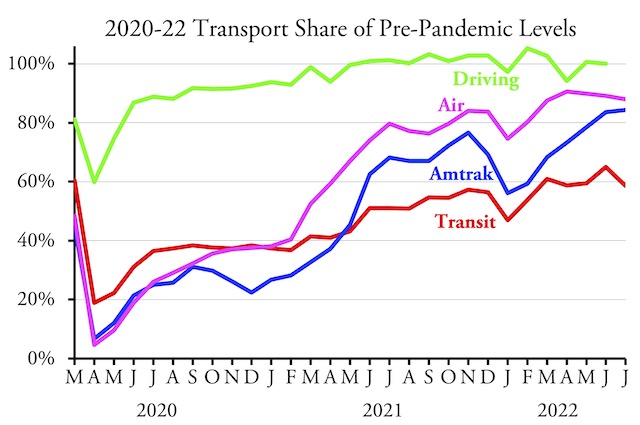U.S. transit systems carried 58.7 percent as many riders in July 2022 as they did in July 2019, according to data released by the Federal Transit Administration yesterday. This is a major setback from June’s 65.0 percent of June 2019. Of course, the increase in June was due to high gas prices and the decline in July was due to falling gas prices.
Amtrak numbers are from its July performance report. Air travel numbers are based on TSA passenger counts. Highway numbers should be available in a week or so.
Amtrak, meanwhile, has pushed up from 83.6 to 84.3 percent while air travel dropped from 89.1 to 87.9 percent of pre-pandemic levels. The air travel numbers include both domestic and international travel; domestic travel numbers for July aren’t available yet, but the last numbers that were available, for April, stood at 97.2 percent of pre-pandemic levels.
As the Antiplanner is on the way out the door for five days of cycling and hiking in Wheeler County, Oregon, I don’t have time for a more detailed analysis of the transit data today. I’ll provide that next week. In the meantime, I hope you enjoy your post-Labor Day summer as much as I plan to.









The decline in transit ridership marks opportunity to steal its customer base once and for all…… private jitney buses and vans offer said option.
In 1914, the owner of a Ford Model T Touring Car in Los Angeles realized he could make a little extra money by getting a chauffer’s license and charging people a nickel for a ride. Within a year, more than 60,000 people in cities all over the country were emulating his example. Jitneys, as they were called (apparently a slang term for a nickel), were faster than streetcars, and since drivers were often willing to depart from fixed routes, they were more convenient as well. Immigrants and poor blacks made excellent use of them or became drivers of such jitneys themselves. The streetcar industry felt threatened by jitney competition. While the streetcars were private, they paid franchise fees to the cities and jitney drivers did not. So streetcar companies asked government for regulatory protection against the jitneys, cities gladly complied. The regulations killed the jitney industry, reducing the number of jitneys nationwide by 90 percent by the end of 1916. But eliminating Jitneys did not save streetcars, whose ridership peaked in 1919, and collapsed by 1929.
Jitneys remained in service in San Francisco well into the mid 1970s…..when BART was conceived in the late 60s fear of jitneys.. was a modest forethought. But jitneys saw their first restrictions…. by late 70s had largely been phased out. Their return in 2010s by Fords. Chariot services….. agency was once again regulated to death.
Government cronyism 101: if it competes against us it must go.
Jitney service connecting northern New Jersey, especially Hudson County, to Manhattan is alive and well. Jitneys are privately owned and operated by dozens of companies.
New Jersey regulates jitneys and in general allows the services to operate flexibly without hassles, even though the jitneys compete directly with New Jersey Transit’s bus, commuter rail, and light rail services.
The jitneys run every few minutes across a vast route network.
The cost between Hudson County, New Jersey and Manhattan is $3 each way.
Reliable ridership estimates don’t exist but on my observations daily ridership is in the tens of thousands.
This successful private bus system is ignored by mass transit commentators.
Here is the most comprehensive report, written in 2010.
https://www.hcnj.us/wp-content/uploads/2022/06/HudsonCountyJitneyStudy.pdf